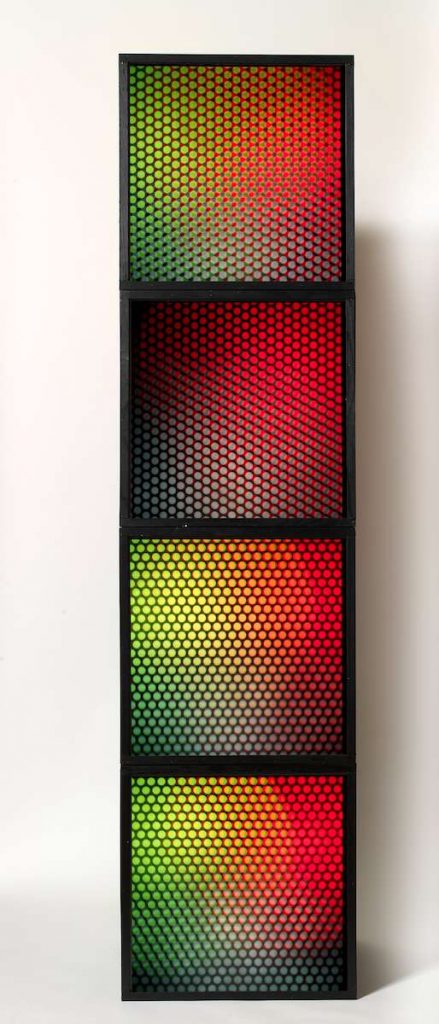Keep It Moving? Conserving Kinetic Art
*What happens when kinetic art devices go into the museum?
http://www.getty.edu/publications/keepitmoving/opening-remarks/

(…)
In 1959 Giovanni Anceschi, Davide Boriani, Gianni Colombo, and Gabriele Devecchi met at the Accademia di Belle Arti di Brera and formed Gruppo T (where T stands for “time”). They started producing works together, and these where exhibited for the first time in Miriorama 1, organized in January 1960 at Galleria Pater in Milan.
The term miriorama, from the Greek myrio (meaning “an endless quantity”) and orao (to see), is the title of the group’s manifesto, written in October 1959 and presented for the Galleria Pater exhibition. The manifesto asserts that reality is an expression of the variable perception of space and time. The traditional idea of art is overtaken: artworks have to be realized in the same material as reality. Movement shall therefore represent a continuous variation in terms of space and time and also reflect the rapid improvement of technology.
The group’s first environmental artwork, Grande oggetto pneumatico, was produced in 1959 and exhibited in Miriorama 1. Composed of seven long polyethylene balloons, it occupied the entire space of the gallery. The shape of the artwork changed constantly because the balloons were alternately inflated through an air nozzle and because the visitors had to move them to walk through the space.
From January to February 1960, the Galleria Pater hosted four solo exhibitions (Miriorama 2 through Miriorama 5), seen as a progression of and follow-up to the first show, each dedicated to a member of the group: Boriani, Devecchi, Colombo, and Anceschi. The second group show, Miriorama 6, was organized in March 1960, and it was the first time Grazia Varisco was a member of Gruppo T.
In 1962, when Gruppo T participated in the exhibition Arte programmata: Arte cinetica, opere moltiplicate, opera aperta at the Olivetti showroom in Milan, Umberto Eco defined the group as “kinetic” and “programmed.”Footnote 2 Artists introduced the use of new industrial materials and objects in their works, such as plastic, polystyrene, electric motors, UV lights, and strobe lamps. The aim of their research was to invite the public to interact with the art, creating a new relationship between visitors, artwork, and exhibition space.
Gruppo T continued its collaborative activities until the end of the 1960s, establishing relations with European groups researching the idea of movement, such as ZERO in Düsseldorf and Groupe de Recherche d’Art Visuel (GRAV) in Paris, and trying to deconstruct the traditional art system. An ending point of the group’s activity could be considered 1968, when Colombo won first prize at the Venice Biennale. From the beginning of the 1970s each artist followed his or her own path, often with interesting experimentations in the field of design.
The history of Milan’s municipal collections of twentieth-century art dates to the beginning of the century and includes acquisitions, donations from private collectors, and long-term loans. Yet it was only in 2010 that the Museo del Novecento opened as a permanent venue that provides a narrative for Italian art from the avant-garde to the present, with a focus on Milan. When the committee started planning the new museum in 2008, it dedicated a section to programmed and kinetic art that included space for Gruppo T, which was not yet represented in Milanese institutions. Important artworks referencing the visual-kinetic research from the late 1950s had entered the museum’s collections from the 1970s through the 1990s; Colombo’s Strutturazione pulsante (1959), Enzo Mari’s Struttura no. 386 (1957), Bruno Munari’s Aconà biconbì (1964–67), and Dadamaino’s Oggetto ottico dinamico no. 1 (1963) were especially significant acquisitions….
(…)
Conservation Issues
Kinetic artworks present considerable conservation and maintenance challenges and, beyond the specificities of individual cases, permanent display is the first matter to be considered. The Museo del Novecento is open seventy hours a week, and thirteen hours each on Thursdays and Saturdays. Artworks on view are activated for long periods, and this causes stress to lights and motors, especially to original motors that had not been designed for long-term use. To address the issue, sensors and timers were installed so that the works are activated only when visitors are present and only for about one minute. While this has considerably reduced the need for extraordinary interventions by technicians, wear and tear remain the primary conservation issues, especially after many years of display.
The Museo del Novecento’s approach thus far has been that of preserving the original components by preemptively replacing them with new ones, even when the originals still work. In this case, the overall “authenticity” of the artwork is potentially preserved, since its original components, such as motors or rubber drive belts, are intact, functional, and available for a possible future reconstruction.
This approach was used during the restoration of Colombo’s Strutturazione pulsante, a work composed of rectangular modular polystyrene panels combined orthogonally; behind the panels, a motor-driven system of slats produces the alternating movement of the panels (fig. 0.1). In conjunction with a cleaning of the polystyrene parts, the museum decided, with the approval of the Archivio Gianni Colombo, to replace the two still functional but very fragile plastic silicon belts (from the late 1950s) with new belts. The original belts were preserved in the archive, so the artwork could possibly be rebuilt with its original components in the future….